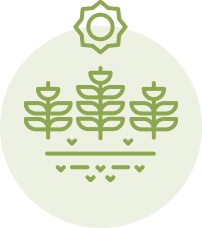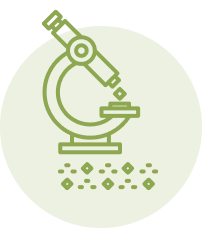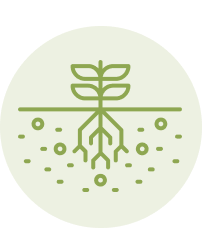Pollinators are important not just for the roles they play in natural ecosystems. They are also extremely valuable in the production of useful crops. Research at Cornell University calculates that pollinators contribute an estimated $29 billion to US food production each year.
Pollinator decline is a growing problem worldwide, including in North America. There are over four thousand wild bee species native to North America and Hawaii. Research indicates that population decline is affecting about half of these species, and almost a quarter are considered at risk for extinction. A diverse pollinator community, composed of strong populations of a range of different species, is most effective for good pollination.
Pollinator decline is not a simple problem and it has multiple causes. Habitat loss, changes in agricultural practices, changing climate, invasive species, diseases, and pesticide exposure are all factors. Despite its complex causes, individuals can take positive action to foster pollinators in their yards and gardens.
The Value of Pollinator Gardens
The value of home landscapes for providing pollinator habitat is recognized in a number of studies. Research at the University of Michigan has shown that small scale flower planting in urban areas can have strong impacts on wild bee populations, even during a single season. With the growing recognition of the importance of pollinators, increasing numbers of gardeners are working to ensure their yards and gardens protect and promote pollinator health.
An effort to promote pollinator habitat was launched by the National Pollinator Garden Network (NPGN) in 2015. The NPGN’s goal is to develop a network of pollinator friendly gardens, with an initial target of one million registered gardens. This goal was reached in just three years, and now registered pollinator gardens cover over 5 million acres, with most gardens in North America.
Pollinator Friendly Garden and Yard Care
Creating gardens that are both attractive and provide benefit habitat to pollinators is not difficult. It just takes an understanding of what habitat features pollinators need and taking steps to meet those needs in your yard and garden.
An important first step is to minimize or eliminate the use of all types of pesticides, even natural and organic products, in your yard and garden. Healthy plants and soils provide natural resistance to insect pests and diseases, so good cultural practices go a long way toward preventing pest problems.
Use low impact pest control methods, including hand picking, as the first choice to control insect problems. Soft-bodied insects like aphids can be sprayed off plants with a stream of water. Many will not survive to climb back onto plants, particularly when the garden contains a healthy beneficial insect population.
If pesticides need to be used, apply them in ways that minimize non-target organism exposure. Choose selective products that affect only the pests being treated when possible. Use spot treatment by applying only to areas being affected by pests instead of treating large areas. Apply pesticides in the late evening, when beneficial insect activity is low.
Pollinator Friendly Plantings
For optimal pollinator habitat, include a range of annuals, perennials, evergreens, trees, and shrubs in the landscape. A landscape that includes plants with varying heights and growing habits helps to create diverse habitat for pollinators and beneficial insects.
Include plant species with a range of bloom times, to provide flowers from spring to fall. Spring blooming species are particularly important, as they provide food early in the season. Spring flowering bulbs can be an excellent way to add early spring color to the landscape. Spring crocus, fritillaria, grape hyacinths, and species tulips are excellent bulb choices.
Consider converting some lawn space to flowering plants to improve pollinator habitat in your yard. Most lawns include areas that are difficult to mow due to slope, irregular shape, or obstacles. Replacing such lawn problem areas with flowering ornamental plants makes lawn care more efficient and less frustrating, while adding beauty to the yard. This type of planting provides habitat for pollinators and beneficial insects while simplifying lawn maintenance. Our Pollinator Wildflower Mix provides an easy option to add pollinator friendly plants to the yard or garden.
Provide Nesting Sites
Most North American native bees build nests in burrows in the soil. Providing areas with bare soil that is not disturbed provides these species with nesting habitat. Some types of mulch, notably lighter materials like compost or shredded leaves, can be used in the garden without disrupting the ability of ground nesting bees to dig their nest tunnels.
Other native bees are cavity nesters, using plant stems, cavities in wood, and brush piles for nesting sites. Nesting areas for these species can be supported by growing species with hollow or pithy stems, including raspberry, elderberry, and hydrangea. Instead of pruning in fall when plants die back, allow at least some dead stems to remain through the winter and into late spring, so bees nesting in the stems can emerge.
Allow dead plant stems to remain through winter instead of removing them in fall. Dead trees and stumps also provide excellent habitat for a wide range of insect species, including cavity nesting bees. Leave dead trees that don’t pose danger to structures in the yard when possible.
Growing ornamental grasses with clump forming (bunching) growth habits, like little bluestem (Schizachyrium scoparium), big bluestem (Andropogon gerardii), switchgrass (Panicum virgatum), and prairie dropseed (Sporobolus heterolepis) is also helpful to create for ground nesting bees, including bumble bees.
You can also create bee houses from wood blocks or bundles of stems. The Xerces Society and Michigan State University have guides for effectively using bee houses.
Butterfly Caterpillar Food Plants
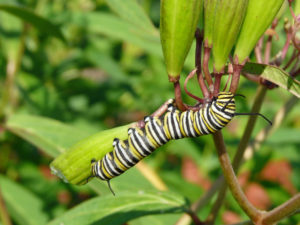
By including plant species that serve as food for butterfly caterpillars, you can encourage butterfly species to thrive in your garden. Examples of larval food plants include:
- Asters
- Carrot family plants like dill, parsley, and fennel
- Clovers
- Grasses
- Milkweed
- Oak
- Sunflower
- Violets
- Willow
Water
Providing a water source is also helpful to provide optimal habitat for beneficial insects. One way to do this is by filling a birdbath, tray, or other shallow container with marbles, stones, or gravel to the top of the container. Fill the container with water to create a water source easy for insects to drink from.
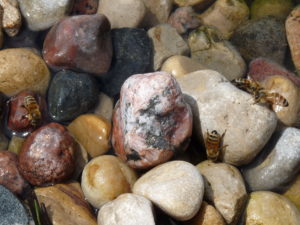
Did You Know
National Pollinator Week began in 2007, creating a week in June to recognize and celebrate the importance of pollinators. For 2020, National Pollinator Week is June 22-28. Since its foundation, the event has blossomed into an international event that celebrates the wide range of insects, birds, and bats responsible for pollinating plants.

